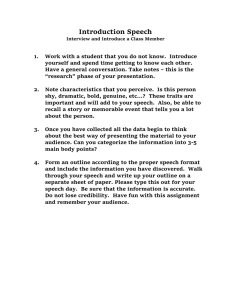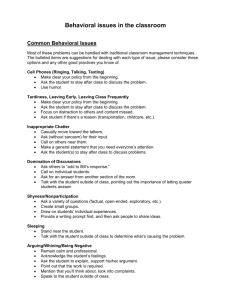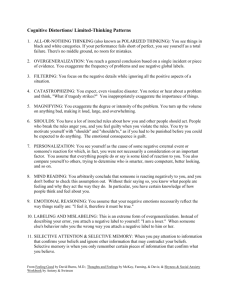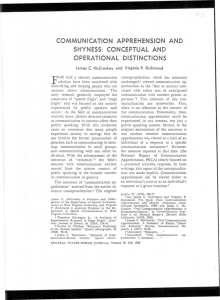20091217161210_HRC_122409_Presentation Handout
advertisement
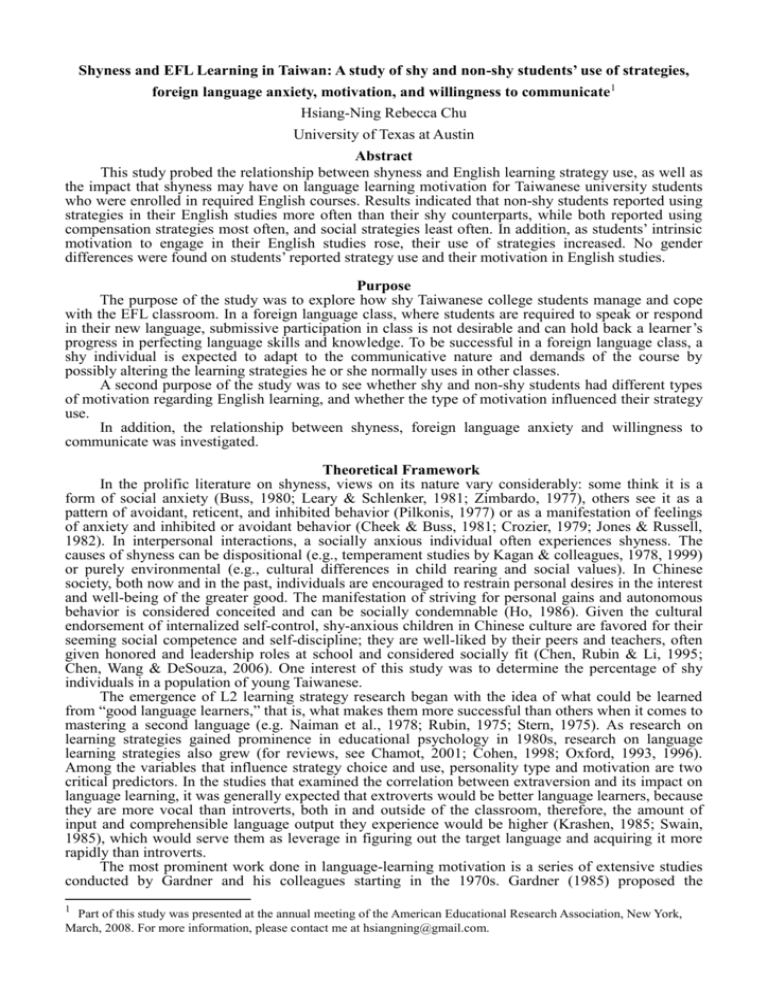
Shyness and EFL Learning in Taiwan: A study of shy and non-shy students’ use of strategies, foreign language anxiety, motivation, and willingness to communicate1 Hsiang-Ning Rebecca Chu University of Texas at Austin Abstract This study probed the relationship between shyness and English learning strategy use, as well as the impact that shyness may have on language learning motivation for Taiwanese university students who were enrolled in required English courses. Results indicated that non-shy students reported using strategies in their English studies more often than their shy counterparts, while both reported using compensation strategies most often, and social strategies least often. In addition, as students’ intrinsic motivation to engage in their English studies rose, their use of strategies increased. No gender differences were found on students’ reported strategy use and their motivation in English studies. Purpose The purpose of the study was to explore how shy Taiwanese college students manage and cope with the EFL classroom. In a foreign language class, where students are required to speak or respond in their new language, submissive participation in class is not desirable and can hold back a learner’s progress in perfecting language skills and knowledge. To be successful in a foreign language class, a shy individual is expected to adapt to the communicative nature and demands of the course by possibly altering the learning strategies he or she normally uses in other classes. A second purpose of the study was to see whether shy and non-shy students had different types of motivation regarding English learning, and whether the type of motivation influenced their strategy use. In addition, the relationship between shyness, foreign language anxiety and willingness to communicate was investigated. Theoretical Framework In the prolific literature on shyness, views on its nature vary considerably: some think it is a form of social anxiety (Buss, 1980; Leary & Schlenker, 1981; Zimbardo, 1977), others see it as a pattern of avoidant, reticent, and inhibited behavior (Pilkonis, 1977) or as a manifestation of feelings of anxiety and inhibited or avoidant behavior (Cheek & Buss, 1981; Crozier, 1979; Jones & Russell, 1982). In interpersonal interactions, a socially anxious individual often experiences shyness. The causes of shyness can be dispositional (e.g., temperament studies by Kagan & colleagues, 1978, 1999) or purely environmental (e.g., cultural differences in child rearing and social values). In Chinese society, both now and in the past, individuals are encouraged to restrain personal desires in the interest and well-being of the greater good. The manifestation of striving for personal gains and autonomous behavior is considered conceited and can be socially condemnable (Ho, 1986). Given the cultural endorsement of internalized self-control, shy-anxious children in Chinese culture are favored for their seeming social competence and self-discipline; they are well-liked by their peers and teachers, often given honored and leadership roles at school and considered socially fit (Chen, Rubin & Li, 1995; Chen, Wang & DeSouza, 2006). One interest of this study was to determine the percentage of shy individuals in a population of young Taiwanese. The emergence of L2 learning strategy research began with the idea of what could be learned from “good language learners,” that is, what makes them more successful than others when it comes to mastering a second language (e.g. Naiman et al., 1978; Rubin, 1975; Stern, 1975). As research on learning strategies gained prominence in educational psychology in 1980s, research on language learning strategies also grew (for reviews, see Chamot, 2001; Cohen, 1998; Oxford, 1993, 1996). Among the variables that influence strategy choice and use, personality type and motivation are two critical predictors. In the studies that examined the correlation between extraversion and its impact on language learning, it was generally expected that extroverts would be better language learners, because they are more vocal than introverts, both in and outside of the classroom, therefore, the amount of input and comprehensible language output they experience would be higher (Krashen, 1985; Swain, 1985), which would serve them as leverage in figuring out the target language and acquiring it more rapidly than introverts. The most prominent work done in language-learning motivation is a series of extensive studies conducted by Gardner and his colleagues starting in the 1970s. Gardner (1985) proposed the 1 Part of this study was presented at the annual meeting of the American Educational Research Association, New York, March, 2008. For more information, please contact me at hsiangning@gmail.com. Socio-Educational Model in which possible motivation characteristics were identified, and the Attitude/Motivation Test Battery (AMTB) to help assess affective factors involved in L2 learning (Gardner & Smythe, 1981). Though findings reported by Gardner and colleagues seem intuitive and echo the experience of most language learners regarding motivation and achievement, some researchers (Crookes & Schmidt, 1991; Dornyei, 1994; Oxford & Shearin, 1994) voiced that motivation variables from the field of educational psychology should be included. Using the framework of Self-Determination Theory (Deci & Ryan, 1985, 2002), Noels partnered with several motivational and second language acquisition researchers (McIntosh & Noels, 2004; Noels, 2001a, 2001b; Noels, Clement, & Pelletier, 1999, 2001; Noels, Pelletier, Clement, & Vallerand, 2000) and reported that identified regulation and intrinsic motivation were most strongly associated with Gardner’s integrative orientation, though integrative association had modest correlations with the less self-determined orientations as well. Instrumental orientation, on the other hand, correlated highly with external regulation. Method Participants and Procedures Participants were 364 Taiwanese students enrolled in Sophomore and Freshman English courses in a private university in Taipei. Of these, 36% were men and 64% were women, with an average age of 20.5 years. Students were from 19 different departments with no English majors included. Students filled out Chinese versions of measures of shyness, language learning strategies, and self-determined motivation as part of a portion of class. Measures The Revised Cheek and Buss Shyness Scale (RCBS). The shyness scale was the 13-item Revised Cheek and Buss Shyness Scale (Cheek, 1983; α=.90, test retest reliability=.88). The items are answered on a 5-point Likert scale. The scale items are written so as to tap into affective and behavioral aspects of shyness without referring to the desire to seek out or avoid social interactions (r=- .30) (Leary, 1991). Scores on the RCBS range from 13 to 65. Cheek proposed that participants scoring over 49 should be considered very shy, and those scoring over 39 be considered shy. A cutoff score of 39 was used for this study to differentiate the shy from the non-shy. Strategy Inventory for Language Learning (SILL). The SILL (Oxford, 1986-1990) was first developed as a measure to assess the use of language learning strategies. Two revised versions of the SILL have become widely used: 80 items for native English speakers who are learning foreign languages, and 50 items for learners of English as a second or foreign language (ESL/EFL) (Oxford, 1990). The SILL uses a 5-point Likert-type scale. The strategies in the SILL are organized into two overarching types, direct and indirect strategies, each with three subcategories. The direct category includes memory strategies, cognitive strategies, and compensation strategies, and the indirect category includes metacognitive strategies, affective strategies, and social strategies. In the current study, the Chinese version of the ESL/EFL SILL was used because the participants were native Mandarin Chinese speakers. The Cronbach alpha of the Chinese version of the ESL/EFL SILL was reported as .94 (Yang, 1992; Hsiao & Oxford, 2002), and .75, .84, .69, .86, .68, and .78 respectively, for the six subcategories. Language Learning Orientation Scale – Intrinsic Motivation, Extrinsic Motivation and Amotivation Subscales (LLOS-IEA). The LLOS-IEA (Noels et al., 2000) was adapted from the Academic Motivation Scale (Vallerand et al., 1989, 1992, 1993), a measure based on Self-Determination Theory (Deci & Ryan, 1985, 2002). The scale has 21 items measuring seven subscales: amotivation, external regulation, introjected regulation, identified regulation, and three dimensions of intrinsic motivation (i.e., knowledge, accomplishment, and stimulation). The original LLOS-IEA used 7-point rating scales. To correspond with the scaling of the other measures I used, and so as not to confuse the participants, a 5-point scale was adopted. The Cronbach alpha of the LLOS-IEA was acceptable for all subscales, varying between .67 and .88 (Noels et al., 2000). All the measures were translated into Chinese, using backward and forward translation. Results and Discussion Using a cutoff score of 39 on the Revised Cheek and Buss Shyness Scale (RCBS), I found that 44% of the participants were labeled shy, and 56% non-shy. The overall mean of 37.7 (SD=8.6) indicated that this group was below threshold on the shyness scale but close to the cutoff. 2 Next, MANOVAs were used to analyze the difference between the two shyness groups on L2 learning strategy use and L2 motivation orientations. The Hotelling’s T-square multivariate test of overall differences indicated that shy and non-shy students’ use of English learning strategies differed, F(7, 351) = 5.71, p< .001. Overall, non-shy students reported use of learning strategies in their English studies more often than shy students. Among the six categories of strategies, compensation strategies were used most often (M=3.50), while social strategies the least often (M=2.85). Compensation strategies include guessing meanings from the context in reading and listening, and using synonyms and gestures to convey meaning to make up for a learner’s limited knowledge. It is no surprise that non-shy individuals would use this strategy often, as they might be less afraid of making mistakes or making fools of themselves than shy individuals. It was, however, unexpected that the shy participants in the study also reported using compensation strategies quite often (M=3.28), even though less often than non-shy participants. As for the infrequent use of social strategies, it can be understood in light of the EFL context in which these participants were situated. Social strategies involve cooperation with an interlocutor, often a native speaker, to make the meaning exchange more smooth. Taiwanese students learn English mostly in classroom settings, where meaning exchange is not required and cooperative learning is not common. In addition, the Hotelling’s T-square multivariate test of overall differences indicated that there were significant differences between shy and non-shy students on their English learning motivation orientations, F(7, 351) = 3.20, p< .01. In subsequent ANOVA tests, identified regulation and intrinsic motivation to know emerged as significant, with non-shy students reporting having more of both motivation regulations compared to their shy counterparts. It seems that non-shy students have incorporated the mastery of the English language as one of their important life goals (identified regulation) and readily engage themselves in English learning activities, because they find pleasure and fulfillment in doing so. However, no gender differences were found on students’ reported strategy use and their motivation in English studies. As for whether motivation types would predict shy and non-shy students’ strategy use, results from a series of hierarchical multiple regressions showed that the factor of intrinsic motivation to know appears to be the most important predictor for both shy and non-shy students for their use of most of the strategies. Lastly, shyness and foreign language anxiety was found to correlate moderately (r = .42, p < .001), indicating that the two constructs may have overlapping attributes but are not identical. Further correlation analyses also showed that the more shyness students reported, the less willing they were to initiate conversations with others, both in Chinese (r = -.53, p < .001) and English (r = -.31, p < .001). Significance In general, non-shy students utilized English language learning strategies more frequently than shy students across the six categories of strategies. Because the relationship between shyness and L2 strategy use has not been widely researched, this study can contribute to this line of research. Moreover, gender differences in strategy use, generally reported across second language acquisition, were not found in this study, which replicated the findings of Ehrman and Oxford’s (1990) study. Among the six categories of language learning strategies, the category least used by students was social strategies. This outcome can be understood in light of the teacher-centered pedagogical approach and the lack of opportunities to engage in cooperative learning in these students’ English classrooms. By contrast, students reported using compensation strategies most often, regardless of their shyness. This indicates that participants in the study, though not English majors, were conscientious about their English studies, by making an effort to comprehend the written material or keep their English communication uninterrupted. This phenomenon corroborated the direction of students’ motivation orientations toward English learning: on the self-determined motivation continuum, the participants scored higher on the subscales that denoted identified regulation and intrinsic motivation. Such findings may provide reassurance and an opportunity for their English instructors to reexamine their course requirements and further tailor the materials to students’ needs. References Buss, A. H. (Ed.). (1980). Self-consciousness and social anxiety. San Francisco: W. H. Freeman and Company. Chamot, A. U. (2001). The role of learning strategies in second language acquisition. In M. P. Breen (Ed.), Learner contributions to language learning: New directions in research (pp.25-43). Harlow, England: Longman. Cheek, J. M., & Buss, A. H. (1981). Shyness and sociability. Journal of Personality and Social Pscyhology, 41(2), 330-339. 3 Chen, X, Rubin, K. H., & Li, B. (1995). Depressed mood in Chinese children: Relations with school performance and family environment. Journal of Consulting and Clinical Psychology, 63, 938-947. Chen, X., Wang, L., & DeSouza, A. (2006). Temperament, socioemotional functioning, and peer relationships in Chinese and North American children. In X. Chen, D. C. French, & B. H. Schneider (Eds.), Peer relationships in cultural context. New York: Cambridge University Press. Cohen, A. D. (1998). Strategies in learning and using a second language. London: Longman. Croizer, W. R. (1979). Shyness as a dimension of personality. British Journal of Social & Clinical Psychology, 18(1), 121-128. Crookes, G., & Schmidt, R. (1991). Motivation: Reopening the research agenda. Language Learning, 41, 469-512. Deci, E. L., & Ryan, R. M. (1985). Intrinsic motivation and self-determination in human behavior. New York: Plenum. Deci, E. L., & Ryan, R. M. (Eds.) (2002). Handbook of self-determination. Rochester: University of Rochester Press. Dornyei, Z. (1994). Understanding second language motivation: On with the challenge! The Modern Language Journal, 78, 515-523. Ehrman, M., & Oxford, R. (1990). Adult language learning styles and strategies in an intensive training setting, The Modern Language Journal, 74(3), 311-327. Gardner, R. C. (1985). Social psychology and second language learning: The role of attitudes and motivation. London: Edward Arnold. Gardner, R. C., & Smythe, P. C. (1981). On the development of the Attitude/Motivation Test Battery. Canadian Modern Language Review. 37, 510-525. (ERIC Document No. EJ247237) Ho, D. Y. F. (1986). Chinese pattern of socialization: A critical review. In M. H. Bond (Ed.), The psychology of the Chinese people (pp. 1-37). New York: Oxford University Press. Hsiao, T-Y., & Oxford, R. L. (2002). Comparing theories of language learning strategies: A confirmatory factor analysis. The Modern Language Journal, 86, 368-383. Jones, W. H., & Russell, D. (1982, December). The social reticence scale: An objective instrument to measure shyness. Journal of personality assessment, 46, 629-631. Kagan, J., & Snidman, N. (1999). Early childhood predictors of adult anxiety disorders. Biological Psychiatry, 46(11), 1536-1541. Kagan, J., Kearsley, R. B., & Zelazo, P. R. (1978). Infancy: Its place in human development. Cambridge, MA: Harvard University Press. Krashen, S. D. (1985). The input analysis. London: Longman Leary, M. R. (1991). Social anxiety, shyness and related constructs. In J. P. Robinson, P. R. Shaver, & L. S. Wrightsman (Eds.), Measures of personality and social psychological attitudes (pp. 182-184). San Diego, CA: Academic Press. Leary, M. R., & Schlenker, B. R. (1981). The social psychology of shyness: A self-presentational model. In J. T. Tedeschi (Ed.), Impression management theory and social psychological research. New York: Academic Press. McIntosh, C. N., & Noels. K. (2004). Self-determined motivation for language learning: The role of need for cognition and language learning strategies. Zeitschrift fur Interkulturellen Fremdsprachenunterricht [Online], 9(2), 19. Naiman, N., Frohlich, M., Stern, H. H., & Todesco, A. (1978). The good language learner. Toronto: Ontario Institute for Studies in Education. Noels, K. A. (2001a). Learning Spanish as a second language: Learners’ orientations and perceptions of their teachers’ communication style. Language Learning, 51, 107-144. Noels, K. A. (2001b). New orientations in language learning motivation: Toward a contextual model of intrinsic, extrinsic, and integrative orientations and motivation. In Z. Dornyei & R. Schmidt (Eds.), Motivation and second language acquisition (pp.43-68). Honolulu: University of Hawaii Press. Noels, K. A., Clement, R., & Pelletier, L. G. (1999). Perceptions of teachers’ communicative style and students’ intrinsic and extrinsic motivation. The Modern Language Journal, 83, 23-34. Noels, K. A., Clement, R., & Pelletier, L. G. (2001). Intrinsic, extrinsic, and integrative orientations of French Canadian learners of English. Canadian Modern Language Review, 57, 424-444. Noels, K. A., Pelletier, L. G., Clement, R., & Vallerand, R. J. (2000). Why are you learning a second language? Motivational orientations and self-determination theory. Language Learning , 50, 57-85. Oxford, R. L. (1990). Language learning strategies: What every teacher should know. New York: Newbury House. Oxford, R. L. (1993). Research on second language learning strategies. Annual Review of Applied Linguistics, 13, 175-187. Oxford, R. L. (Ed.). (1996). Language learning motivation: Pathways to the new century. Honolulu: University of Hawaii Press. Oxford, R., & Shearin, J. (1994). Language learning motivation: Expanding the theoretical framework. Modern Language Review, 78, 12-28. Pilkonis, P. A. (1977). The behavioral consequences of shyness. Journal of Personality, 45, 596-611. Rubin, J. (1975). What the “good language learner” can teach us. TESOL Quarterly, 9, 41-51. Stern, H. H. (1975). What can we learn from the good language learner? The Canadian Modern Language Review, 31, 304-318. Swain, M. (1985). Communicative competence: Some roles of comprehensive input and comprehensive output in its development. Rowley, MA: Newbury House. Yang, N.-D. (1992). Second language learners’ beliefs about language learning and their use of learning strategies: A study of college students of English in Taiwan. Unpublished doctoral dissertation, the University of Texas at Austin. Zimbardo, P. G. (Ed.). (1977). Shyness: What it is, what to do about it. Reading, MA: Addison-Wesley Publishing Company. 4


